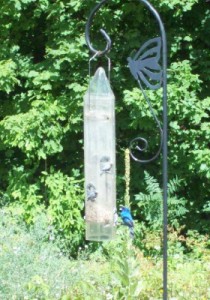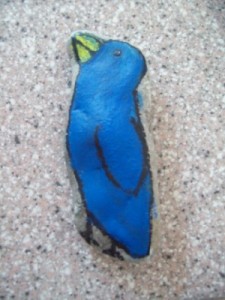If you’ve been reading our recent posts, you’ve probably heard a lot about our recent summer vacation trip to Northern Michigan. We got to stay at a really awesome log cabin (which Annie, my mom, will inform you more about later). I got to do and see so many fun and exciting things. I was able to pick and eat wild berries and see two wild turkeys. I also saw a few chickadees, a yellow finch, and plenty of chipmunks that often came to the bird feeder just outside the window of the cabin. There was one bird in specific that came to our bird feeder that I’m going to talk about today. That bird is the Indigo Bunting.
One night we had our cousins Mark and Karen over at our log cabin. We were having some snacks at our really cool wooden table. The table faces the window that looks out at the bird feeder. All of a sudden this really pretty bright blue bird came to the feeder.  This bird usually came in the morning for a snack. Right away our cousin Karen noticed the bird. She is very “nature-smart” and knew exactly what it was. She told us it was an Indigo Bunting and that this wasn’t a common visitor. The next day she also printed out a little more info on this bird for us. So, using the information she gave me and some of my own research, I’ve decided to tell you more about this uncommon but amazing bird.
This bird usually came in the morning for a snack. Right away our cousin Karen noticed the bird. She is very “nature-smart” and knew exactly what it was. She told us it was an Indigo Bunting and that this wasn’t a common visitor. The next day she also printed out a little more info on this bird for us. So, using the information she gave me and some of my own research, I’ve decided to tell you more about this uncommon but amazing bird.
Male Indigo Buntings are bright blue during their mating season. They are brown with only a few tints of blue the rest of the year. The female Indigo Buntings are brown the whole year. I figured since the Indigo Bunting that we saw was blue. It must have been a male and it must have been the Indigo Bunting mating season. I checked to see when their mating season was… and I was right! Their mating season is around a time period from about April to July (we went on vacation in July). I also learned that Indigo Buntings migrate to the West Indies, southern Mexico, Central America, and sometimes to Western Europe. I think when we saw the Indigo Bunting it was one of those moments where we were all in the right place at the right time. We were with our cousin Karen, the nature expert, we were right by the window, and we were in Michigan in July so we got to see the bird’s wonderful blue color. How cool is that!
I also found that Indigo Buntings eat seeds, (which would make sense since it was at our bird feeder), insects (including grasshoppers and caterpillars), and berries. When we were at the cabin the bird seed started to “get low,” so we thought it’d be good to get some more bird food. We got some but it wasn’t exactly the same as the original bird food in the feeder. We put it in and, well… we never really saw the Indigo Bunting come back to the feeder. The chipmunks sure liked the food, but apparently the Indigo Bunting didn’t. I felt really bad. But, after I did my research, I didn’t feel so bad anymore because Indigo buntings eat berries which there were tons of at the cabin, and they also eat insects. There were tons of grasshoppers and other bugs all around.
I thought I should share with you more about how an Indigo Bunting looks, how long it lives, if it’s endangered, and how they help us and interact with us. An Indigo Bunting is quite a small bird. It’s 11.5 cm to 13 cm long and weighs 12 to 18 g. They have short, cone-like beaks. Their legs and feet can be black or gray. Indigo Buntings live up to ten years of age. They are a protected bird, but not endangered. Bird watchers like watching Indigo Buntings and they are known to be popular pets in Europe and Mexico. Also, people like to attract them to their gardens because they like to eat insects.
In Michigan, I found a rock that I thought looked like a bird so I decided to paint the rock to look like an Indigo Bunting and give it my cousin Karen. My paint set that I brought had just the right color blue. It was perfect!  I think Indigo Buntings are really amazing creatures that God created. I’m glad I was able to learn more about this bird and share info with you.
I think Indigo Buntings are really amazing creatures that God created. I’m glad I was able to learn more about this bird and share info with you.
I hope you enjoyed my article. If you have any interesting bird sightings or really any interesting animal sightings… please share with us in the comment box below. Thanks!!

